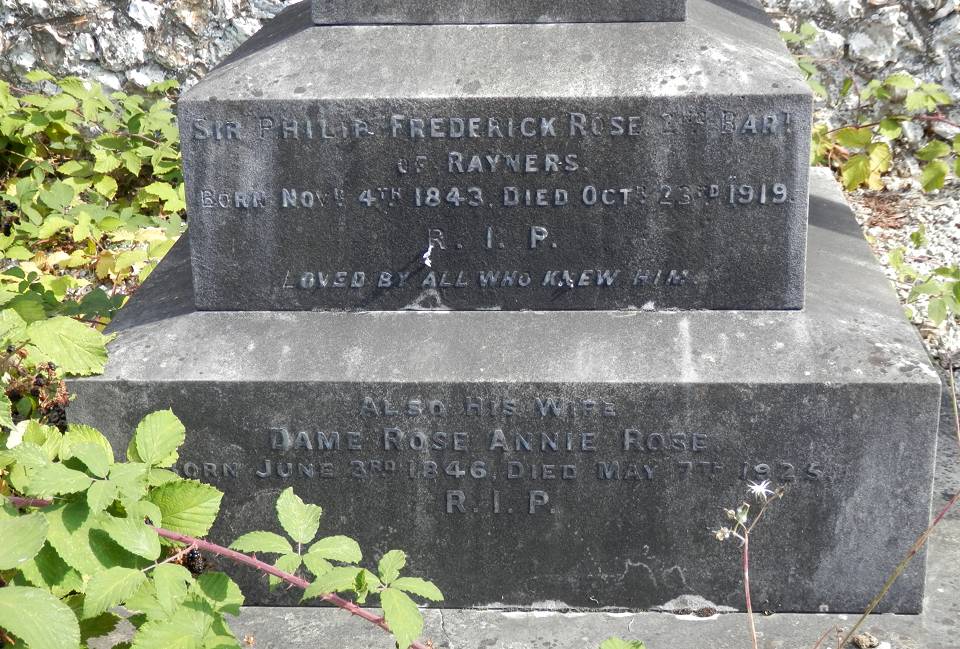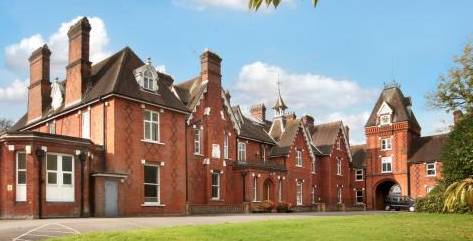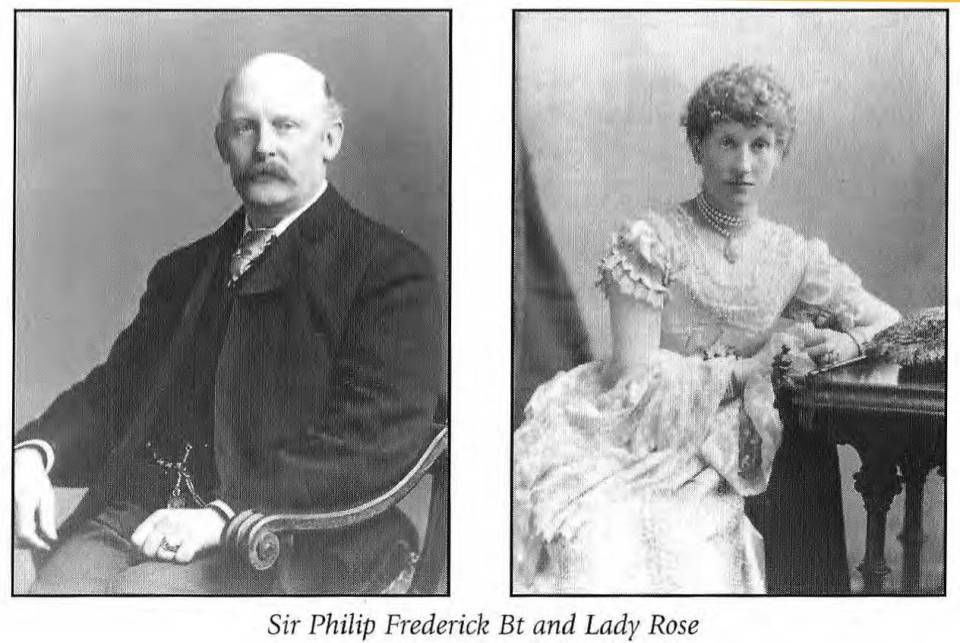Oratory of the Immaculate Heart of St. Mary and St. Philip, Rayners
The Rose family, Tylers Green, Sir Philip Rose Bt., Baxter, Rose and Norton
Sir Philip Frederick Rose Bt.
Correspondence with the Bishop of Northampton
Chapel at Rayners
Father Herbert Ignatius Beale arrives 1889.
The Rose Family
As local families go, the Rose clan is an old one. They were around during the reign of Henry VIII. Since then the names of numerous Aldermen, Mayors and Burgesses whose surname was Rose, crop in local and county records.
Sir Philip Rose Bt. – First Baronet
Wycombe born Philip Rose was a solicitor who lived in London, where he was a partner in the firm Baxter, Rose and Norton. He undertook the legal work for the proposed Great Northern Railway Line, purchasing land and drafting parliamentary Bills. He played a considerable part in bringing the first railway line to High Wycombe – the branch line from Maidenhead which used to go from Bourne End via Loudwater.
He worked tirelessly for charity and was the founder of the Brompton Hospital in London. Benjamin Disraeli, a friend and neighbour at Hughenden nominated Philip Rose to Queen Victoria for a Baronetage.
With the local community in mind, Philip Rose built for the Church of England, St. Margaret’s Church – named after his wife Margaretta.
Rayners became the employer and home to a great number of people from the the village of Tylers Green.
Sir Philip Rose Bt. died in 1883. The oldest son – Philip Frederick Rose inherited the title and Rayners.
Sir Philip Frederick Rose Bt., Second Baronet.
Philip Frederick was educated at Harrow and followed his father into the legal profession. He, his wife and children lived usually at Rayners from May to October and in London for the remainder of the year.
10 January 1885
This report in LONDON FIGARO caused a bit of a stir in Penn and Tyler’s Green.
The reception of Sir Philip and Lady Rose into the Roman Catholic Church has created some sensation in South Kensington. Sir Philip was formerly Church Warden at St Matthias, Earls Court and his perversion will be a loss in more senses than one to the cause.
Back in Tyler’s Green, any fear of change and disruption on the estate and in the village soon evaporated when it became clear that the new Squire had every intention of carrying on with the work started by his father:
- A bell tower was added to St Margaret’s Church
- Sir Philip Frederick donated a block of land and upon it built the Tyler’s Green Parish Rooms
- A grand Fete and fireworks party was held in the estate grounds and all proceeds went to the upkeep of the Parish Rooms.
Getting to Mass on Sunday, however, was proving to be a bit of a headache for the Rose family. The nearest Catholic Church at the time was St Peter’s in MarIow.
March 1889
– Sir Philip wrote to Bishop Arthur Riddell, Bishop of Northampton.
Rayners
Penn
BUCKS Station, Loudwater, GWR
March 1889
The Rt. Rev the Lord Bishop of Northampton
My dear Lord Bishop
By the death of my mother I have come into possession of the family home here. I am a convert to the Church of some four years ago but owing to my Mother’s occupancy during her life of this place, the question which now presses upon me had not hitherto arisen.
I allude, of course to the provision of means for the practice of my religion when resident here. The position is this. I am distant, between 8 and 9 miles from Great Marlow which is the nearest Catholic Church, and as your Lordship will appreciate, it is quite impossible for Lady Rose and myself to drive this long distance, to say nothing of my family (six children) and several Catholic Servants.
Under the circumstances, I shall be glad of your Lordship’s kindly advice as to what is to be done. The house here is a large one, in the sense of there being a great many rooms in it and there is one which hitherto has been used as an organ chamber which could be adapted for the purposes of a small chapel. If, therefore your Lordship would be willing to authorise the celebration of Mass in the house, I shall be ready to provide all the necessary fittings and appliances for a Chapel if some arrangement could be made for Mass being said on Sundays and Holy Days, during such time as my family are resident here.
I ought to mention that still being engaged in business, I am not able to reside there all year round.
But as I know that my friend Lord Alexander Lennox, when resident at Stoke Farm near Slough, used to have Mass in the house when there, which was discontinued when he was in town – I suppose such an arrangement as I should desire would be practicable.
I should, of course be prepared to entertain any Priest who came to the house for Sunday.
May I ask your Lordship’s kindly advice and assistance?
I am my dear Lord Bishop
Yours very faithfully
Philip F Rose
20th March 1889 – The Bishop replied
Bishop’s House
Northampton
20th March 1889
I can make the Chapel at Rayners into a public oratory for the Catholics of Rayners and the neighbourhood; the chapel would be open to the public.
- This I am willing to do and allow it be a public oratory until such a time as there is Mass said on Sundays in High Wycombe.
- After that it will be necessary to apply to the Holy See for leave to have a private oratory, if you wish.
- The Chapel must not have a bedroom above it.
- I am prepared to provide you with an Altar Stone if you have not got one.
- At present I cannot provide you with a priest, but I am willing to give leave for saying Mass and faculties to any priest you may secure, if he has faculties for his own diocese.
- I say at present because I hope to be able to send a priest to High Wycombe, this will depend however, on means for his support.
Arthur Riddell
Bishop of Northampton.
22nd July 1889 – Sir Philip wrote back to the Bishop
Rayners
Penn
BUCKS
22nd July 1889
My dear Lord Bishop
I do not hesitate to say at once that the arrangement suggested by your Lordship will be quite acceptable and I hope to hear, after your interview with the priest on Wednesday, that he will agree to them as a condition upon which I am bound to pay £100 a year.
The only alteration I should venture to suggest in the timetable would be that we should have a second Mass at Rayners, as soon after the priest arrives from High Wycombe, having regard to any confessions he may have to receive. Say that the priest leaves Wycombe (after 8 am Mass) by 8:45, he would then be at Rayners by 9:15 or thereabouts, and Mass could follow at 9:30 or 9:45. Breakfast would follow Mass, an arrangement that would probably suit the priest’s comfort better than Communion at 9:30 and breakfast between Communion and Mass.
Of course there will be an offertory at Rayners and no doubt some Catholic friends will from time to time be there, whose offerings will go to help the Wycombe Mission.
Believe me, my dear Lord Bishop
Yours very truly
Philip F Rose
The result of this correspondence was the arrival of Father Job Wallace who went to Rayners for a very short time. It is known that he visited High Wycombe but whether he said Mass in High Wycombe and where, is not known. Following Father Wallace, another priest was appointed, his identity is unknown, but his stay too is believed to have been short. Over the next month or two, until the arrival of Father Beale. it is believed that a number of outside priests – possibly Oratorians, known from Sir Philip Frederick’s reception into the Church at the Brompton Oratory, came out to say Mass on an occasional basis. It is almost certain however, that Mass was said in the Chapel from July/August until November 1889, celebrated by many and various priests.
On 25th July 1889 Bishop Arthur Riddell appointed Father Herbert Ignatius Beale, as Chaplain to Sir Philip Frederick Rose Bt. He had been the Chaplain to the Scott-Murray family at Danesfield House, Medmenham near Marlow. Father Beale is believed to have taken up his appointment at Rayners in September 1889. The Revd G. V Bull was appointed to Danesfield in succession to Father Beale.
4th October 1889 – The Catholic Times
“Oratory of the Immaculate Heart of St. Mary and St. Philip, Rayners, Penn, Bucks.
Last Sunday special services were held here in the thanksgiving for the harvest and all other temporal blessings. The chapel was very prettily decorated with flowers, wheat, grapes and fruit, which afterwards, with the offertories of the day were sent to the Wycombe Cottage Hospital. There was Exposition of the Blessed Sacrament with special devotions in the afternoon.”
Sit Philip’s request for a chaplain at Rayners without doubt enabled Bishop Riddell to turn his attention to establishing a mission in High Wycombe. The Bishop would have been well aware of this large town without a priest beforehand. But with all of the other missions being opened at this time, he would have been very pressed for money and priests, probably stretched to his limits.
Father Herbert Ignatius Beale was to become the first priest of the new mission of Saint Augustine’s, High Wycombe.
Death of Sir Philip Frederick Rose, Bart – 23rd October 1919
The last years of Sir Philip’s life were marked by considerable tragedy.
His oldest son Vivian, a grandson and a son-in-law were all killed in the First World War. Vivian Rose, though over 45 years old had volunteered. He was severely injured in battle at Loos.
“My dear boy”, recorded the grief-stricken father, “returned home a shattered wreck” He lived for only a few months.
On 23rd October 1919 at 4pm, at the age of 76, Sir Philip Frederick Rose died.
Following the funeral he was interred in the family vault at St Margaret’s Church, Tylers Green. The funeral was reported widely in the Press.
Friday 31st October 1919. Bucks Free Press.
TYLERS GREEN, FUNERAL OF SIR PHILIP ROSE, Bart
“It was a bright autumnal day but a piercingly cold wind blew over the countryside and was keenly felt in the burial ground of St Margaret’s Church at Tylers Green. On Monday morning at 1O:30am a Requiem Mass was said in the Chapel (at Rayners) in the presence of relatives and personal friends of the deceased gentleman. The impressive service was conducted by Rev Canon Peacock assisted by the Rev Canon Flint from Thetford (formerly Priest at Wycombe for 22 years and Chaplain to the deceased Baronet). Rev A Tillet (Marlow) and the Rev Gerald Flanagan served the Mass. Mr Summersby acted as Cross Bearer and Misters McVey and W Jemmett were the acolytes. Masters Leo Finlayson, Leonard Watson and Tulio Caine carried respectively the Holy Water vat, the incense boat and the thurible.
During the celebration, the six unbleached candles around the coffin remained lighted and also four candles on the altar. On the coffin there was a superb wreath of roses from Lady Rose, another of chrysanthemums from the deceased’s children and a third from his grandchildren.
After the Mass, the officiating Priest, vested in cope said the prayers immediately preceding the Committal Service. When the prayer beginning ‘May the Angels lead thee unto paradise’ was reached, a procession was formed and headed by the cross bearer and acolytes, the chief mourners and other sympathising relatives walked to the place of internment. The route taken was by the drive and the Church path into Hammersley Lane. The coffin was conveyed on a wheeled bier. On its arrival at the family vault which is situated under a portion of Tylers Green Church, the grave was blessed and the verses of the Psalm ‘Blessed be the Lord God of Israel’ were recited alternately by the priests. After the coffin had been sprinkled and incensed, during which The Lord’s Prayer was said, it was lowered into the vault.”

The Mourners included the Marquis of Lincolnshire (Lord Lieutenant of Bucks), Earl Howe, Mr Coningsby R Disraeli, Mr Baring du Pre MP, the Mayor of High Wycombe (Mr (Owen Haines), Rev G Hayward (Vicar of Tylers Green), Mr G W Arnison (Headmaster of The Royal Grammar School), Mr Scanes (Solicitor to the London, Brighton and South Coast Railway), members of the following families: – Vernon, Glenister, Wethered, Borlase, Wheeler, Perfect, Evans, Beale, Layne, Winter and Cakebread.
The Butler and Head Gardener at Rayners were among the named mourners as were estate and house workers and the Land Girls.
The names of those who sent floral tributes filled a further 18 inches of column space in the Bucks Free Press. Personal Tributes from the Vicar of Tylers Green, the Beaconsfield Bench and Aylesbury Magistrates also appeared in the paper.
The Bucks Free Press shall have the last word “During the Mass and during the internment, the bell of St Margaret’s Church was tolled and the flag in the Church yard was hoisted half-mast. The parishioners and the school children were admitted to the vault after the funeral ceremony, practically the whole village attending to pay their tribute of respect to the memory of a universally loved Squire.”
The Chapel at Rayners closes
Lady Rose contacted Canon Peacock and the Bishop with the news that she would be moving from Rayners to Shanklin, Isle of Wight. Subsequently, Canon Peacock with a cart borrowed from Mr Borlase moved the effects from the Chapel. A few items were brought to Wycombe, the rest to Beaconsfield.
From ‘Gem of the Diocese’ a history of St Augustines Church, High Wycombe, by Sheila Mawhood, 2003.


